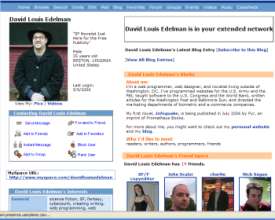LibraryThing seems to have a new competitor. Or, at least, I’ve just become aware of them.
I’ve made no secret about the fact that I’m a big fan of LibraryThing. I’ve spent hours and hours tweaking my LibraryThing profile, adding books to my catalog, and just browsing around other people’s shelves. I’ve spoken with Tim Spalding, LibraryThing’s founder, and he’s taken the time to respond to e-mails of mine and feature me on the LibraryThing blog once or twice.
So I felt a little like a cheating spouse when I responded to someone’s invitation to sign up for a Shelfari account last week. But it was actually much easier than cheating on a spouse, because I didn’t have to go through that whole tedious seduction and getting-to-know-you routine. I exported my whole LibraryThing catalog in about three clicks, and imported it right into Shelfari. In a way, it was like moving in with your mistress and skipping straight to the seven-year-itch all in one shot.
Here are screen captures of my catalog on LibraryThing and Shelfari, side by side. (Visit my shelf on Shelfari.)


After noodling around with Shelfari a little bit, here’s a synopsis of my thought process:
- The name “Shelfari” is incredibly lame.
- Shelfari looks slicker than LibraryThing.
- Shelfari is more user-friendly than LibraryThing.
- LibraryThing is fairly slick and user-friendly in the first place.
- So why would I switch to Shelfari?
The big difference between LibraryThing and Shelfari is that LibraryThing caps its free accounts at 200 books; Shelfari doesn’t appear to have any limits. But keep in mind that the LibraryThing rates are eminently reasonable. $10 a year for all you can catalog, or $25 for a lifetime membership.
Oh yeah, and Shelfari has a Facebook application. (I see that LibraryThing is testing out MySpace and LiveJournal widgets, which is cool, but IMHO they need to get cranking on a Facebook app.)
But there’s a huge amount of functionality that LT has which Shelfari doesn’t seem to have. I went browsing through “my shelf” on Shelfari and discovered that my copy of Shel Silverstein’s Where the Sidewalk Ends doesn’t have Silverstein listed as the author, only as the illustrator; and despite the fact that there’s an “Edit” link next to Edition Details, there doesn’t seem to be any way to edit that information. I was able to change editions to one which does have the author listed… but this one doesn’t have an illustrator listed. LT, by contrast, lets you edit book details to your heart’s content and upload custom covers that the whole community can use. Does the system think that “J.D. Salinger” and “JD Salinger” are two different people? Easy enough to fix that in LibraryThing.
 This community focus is one of the things that makes LibraryThing so appealing. It’s kind of like — well, a library. It’s really, really easy to import and export your entire catalog so you can use it in other applications. Put it on your blog? Tie it in to your Firefox? Access it from your cell phone? No problem! If there are inaccuracies in the catalog, everybody pitches in to help fix it. If you read through the help menus and fine print, you’ll see quirky little bits of humor that give the site some attitude. “If the buzz page doesn’t convince you,” says a little blurb on the LibraryThing home page, “you cannot be convinced. Go away.” There’s a lack of commercial focus that’s very reminiscent of that library feeling. Come on in! Put your feet up, hang around as long as you like, buy some of the books on the Community Used Book table in the back if you’d like, but no pressure.
This community focus is one of the things that makes LibraryThing so appealing. It’s kind of like — well, a library. It’s really, really easy to import and export your entire catalog so you can use it in other applications. Put it on your blog? Tie it in to your Firefox? Access it from your cell phone? No problem! If there are inaccuracies in the catalog, everybody pitches in to help fix it. If you read through the help menus and fine print, you’ll see quirky little bits of humor that give the site some attitude. “If the buzz page doesn’t convince you,” says a little blurb on the LibraryThing home page, “you cannot be convinced. Go away.” There’s a lack of commercial focus that’s very reminiscent of that library feeling. Come on in! Put your feet up, hang around as long as you like, buy some of the books on the Community Used Book table in the back if you’d like, but no pressure.
 Here’s the problem: MySpace is an abomination. Nothing works. The things that do work are poorly designed and shoddily implemented. Here’s just a small sampling of problems I’ve been having:
Here’s the problem: MySpace is an abomination. Nothing works. The things that do work are poorly designed and shoddily implemented. Here’s just a small sampling of problems I’ve been having: